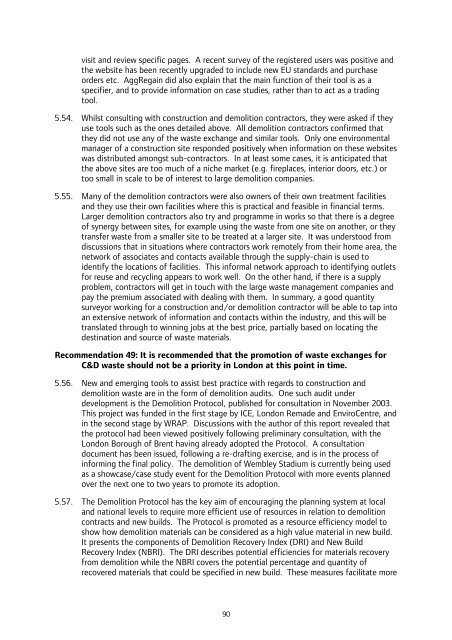London Wider Waste Strategy - London - Greater London Authority
London Wider Waste Strategy - London - Greater London Authority
London Wider Waste Strategy - London - Greater London Authority
Create successful ePaper yourself
Turn your PDF publications into a flip-book with our unique Google optimized e-Paper software.
visit and review specific pages. A recent survey of the registered users was positive and<br />
the website has been recently upgraded to include new EU standards and purchase<br />
orders etc. AggRegain did also explain that the main function of their tool is as a<br />
specifier, and to provide information on case studies, rather than to act as a trading<br />
tool.<br />
5.54. Whilst consulting with construction and demolition contractors, they were asked if they<br />
use tools such as the ones detailed above. All demolition contractors confirmed that<br />
they did not use any of the waste exchange and similar tools. Only one environmental<br />
manager of a construction site responded positively when information on these websites<br />
was distributed amongst sub-contractors. In at least some cases, it is anticipated that<br />
the above sites are too much of a niche market (e.g. fireplaces, interior doors, etc.) or<br />
too small in scale to be of interest to large demolition companies.<br />
5.55. Many of the demolition contractors were also owners of their own treatment facilities<br />
and they use their own facilities where this is practical and feasible in financial terms.<br />
Larger demolition contractors also try and programme in works so that there is a degree<br />
of synergy between sites, for example using the waste from one site on another, or they<br />
transfer waste from a smaller site to be treated at a larger site. It was understood from<br />
discussions that in situations where contractors work remotely from their home area, the<br />
network of associates and contacts available through the supply-chain is used to<br />
identify the locations of facilities. This informal network approach to identifying outlets<br />
for reuse and recycling appears to work well. On the other hand, if there is a supply<br />
problem, contractors will get in touch with the large waste management companies and<br />
pay the premium associated with dealing with them. In summary, a good quantity<br />
surveyor working for a construction and/or demolition contractor will be able to tap into<br />
an extensive network of information and contacts within the industry, and this will be<br />
translated through to winning jobs at the best price, partially based on locating the<br />
destination and source of waste materials.<br />
Recommendation 49: It is recommended that the promotion of waste exchanges for<br />
C&D waste should not be a priority in <strong>London</strong> at this point in time.<br />
5.56. New and emerging tools to assist best practice with regards to construction and<br />
demolition waste are in the form of demolition audits. One such audit under<br />
development is the Demolition Protocol, published for consultation in November 2003.<br />
This project was funded in the first stage by ICE, <strong>London</strong> Remade and EnviroCentre, and<br />
in the second stage by WRAP. Discussions with the author of this report revealed that<br />
the protocol had been viewed positively following preliminary consultation, with the<br />
<strong>London</strong> Borough of Brent having already adopted the Protocol. A consultation<br />
document has been issued, following a re-drafting exercise, and is in the process of<br />
informing the final policy. The demolition of Wembley Stadium is currently being used<br />
as a showcase/case study event for the Demolition Protocol with more events planned<br />
over the next one to two years to promote its adoption.<br />
5.57. The Demolition Protocol has the key aim of encouraging the planning system at local<br />
and national levels to require more efficient use of resources in relation to demolition<br />
contracts and new builds. The Protocol is promoted as a resource efficiency model to<br />
show how demolition materials can be considered as a high value material in new build.<br />
It presents the components of Demolition Recovery Index (DRI) and New Build<br />
Recovery Index (NBRI). The DRI describes potential efficiencies for materials recovery<br />
from demolition while the NBRI covers the potential percentage and quantity of<br />
recovered materials that could be specified in new build. These measures facilitate more<br />
90
















